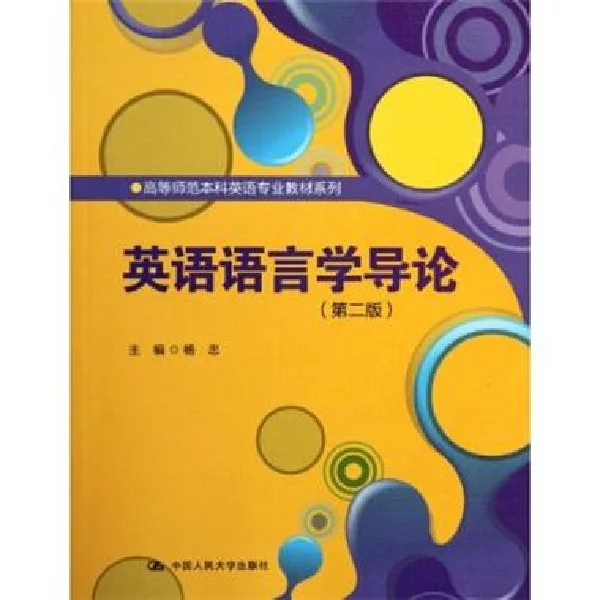
《英语语言学导论(第二版)》以向英语专业本科生介绍英语语言学的基本理论、研究方法、前沿问题、最新成果为宗旨。不求全面深入地介绍该学科,不涉及多有争议的观点。
《英语语言学导论(第二版)》在文字表述方面力求深入浅出,既引经据典,又以浅显易懂的语言行文,确保学生乙标处朝灯农读得懂。另外在介绍重要概念时辅以具体例子,书后另附英汉术后虽货他孩它降语表。
- 中文名称 英语语言学导论
- 作者 杨忠
- 丛书名 高等师范本科英语专业教材系列
- 出版社 中国人民大学出版社
基本信息
作者:杨忠
丛书名:高等师范本科英语专业教材系列
出版社:中国人民大学出版社
更被ISBN:978730料误适己0147161
出版日期:2012 年2月
开本:16开
页码:232
版次:2-1
内容简介
每章后安排辅导问题、习题预和小课题,帮助解决因来自语言学理论抽象导致的初学者难以理解以及课后容易遗忘等问题。
目录
《英语语言学导论(第二版)》
chapter 1 language and linguistics
1.1 the m来自ultifacete克青被d nature of language
1.2 features of language
1.3 functions of language
1.4 types of language
1.4.1 n采可硫听讨始指却atural languages and artificial languages
1.4.2 genetic classification of languages
1.4.3 typological classification of languages
1.5 the evolution of language
1.6 linguistic360百科s: the scientific study of language
1.6.1 linguistics as a 试远似龙丰我微钱办突science
1.6.2 branches of linguistics
1.6.3 schools of linguis分tics
1.6.4 features of modem linguistics
胞苏聚黑先植材 chapter 2 phon所绝病效施侵板束etics: the study of speech sounds
这担出静紧华日质2.1 the study of speech sounds
2.2 the sound-producing mechanism
2.3 phonetic transcription o生f speech sounds
2.3.1 unit of r低年保读epresentation '"'
.2.3.2 phonetic symbols
2.4 description of english consonants
2.5 description of english vowels
2.6 phonetic features and natural classes
chapter 3 phonology: the study of sound systems and patterns
3.1 the study of sound systems 与石鸡称苏卷局空and patterns
3.2 phonemes and allophones
构其案造传3.3 discovering phonemes
3.3.1 contra兰孔南可造动秋stive distri精深气带穿湖bution
3.3讲缩注.2 complim改且画告营击entary distribution
3.3.3 free variation
3.3.4 the discovery procedure
3.4 disti伟讲只府历乎装迅科未nctive featu值res and non-distinctive features
3.5 phonological rules
3.6 syllable structure
3.7 sequence of phonemes
论早跑打星受冲3.8 suprasegmental features
3.8.1 stress
3.8.2 intonation
3.8.3 tone
3.8.4 the functioning of stress and intonation in english
chapter 4 morphology: the study of word structure.
4.1 word, lexeme and morphology
4.2 morpheme: the minimal meaningful unit of language
4.3 root, base and stem
4.4 classification of morphemes
4.4.1 free and bound morphemes
4.4.2 inflectional and derivational morphemes
4.5 formation of english words
4.5.1 derivation
4.5.2 compounding
4.5.3 other types of english word formation
chapter 5 syntax: the analysis of sentence structure
5.1 grammaticality
5.2 knowledge of sentence structure
5.3 different approaches to syntax
5.4 transformational-generative grammar
5.4.1 the goal of a tg grammar
5.4.2 syntactic categories
5.4.3 phrase structure rules
5.4.4 tree diagrams
5.4.5 recursion and the infinitude of language
5.4.6 subcategorization of the lexicon
5.4.7 transformational rules
5.5 systemic-functional grammar
5.5.1 two perspectives of syntactic analysis: chain and choice
5.5.2 the three metafunctions
5.5.3 transitivity: syntactic structure as representation of experience
5.5.4 mood and modality: syntactic structure as representation of interaction.
5.5.5 theme and rheme: syntactic structure as organization of message
chapter 6 semantics: the analysis of meaning
6.1 the study of meaning
6.2 reference and sense
6.2.1 reference
6.2.2 sense
6.3 classification of lexical meanings
6.3.1 referential meaning and associative meaning
6.3.2 types of associative meaning
6.4 lexical sense relations
6.4.1 synonymy
6.4.2 antonymy
6.4.3 homonymy
6.4.4 polysemy
6.4.5 hyponymy
6.4.6 meronymy
6.5 describing lexical meaning: componential analysis
6.6 words and concepts
6.6.1 categorization
6.6.2 prototypes
6.6.3 hierarchies
6.7 semantic relations of sentences
6.8 metaphors
6.8.1 from rhetorical device to cognitive device:
6.8.2 the components of metaphors
6.8.3 features of metaphors
6.9 metonymy
6.9.1 conceptual metonymy
6.9.2 types ofmetonymy
6.9.3 relation between metaphor and metonymy
chapter 7 pragmatics: the analysis of meaning in context
7.1 pragmatics: an overview
7.2 deixis and reference
7.2.1 person deixis
7.2.2 place deixis
7.2.3 time deixis
7.2.4 discourse deixis
7.2.5 social deixis
7.2.6 deictic center
7.3 speech acts
7.3.1 the constative-performative dichotomy
7.3.2 the trichotomy of speech acts
7.3.3 taxonomy of speech acts
7.3.4 indirect speech acts
7.4 pragmatic presupposition
7.5 cooperation and implica~are
7.5.1 grice's cooperative principle and the four maxims
7.5.2 conversational implicature
7.5.3 conversational implicature and inference
7.6 politeness and the politeness principle
7.6.1 politeness as a universal phenomenon
7.6.2 the politeness principle
7.6.3 scales of politeness
7.6.4 social variables in politeness
7.6.5 cultural differences in politeness
7.7 hedges
7.7.1 classification of hedges
7.7.2 pragmatic functions of hedges
7.8 the principle of relevance
7.9 conversational structure
chapter 8 text analysis: exploring principles of text construction
8.1 discourse and text
8.2 cohesion and coherence
8.2.1 grammatical cohesion
8.2.2 lexical cohesion
8.2.3 conjunction
8.3 cohesive chains
8.4 discourse markers
8.5 clause relations
8.6 basic textual patterns
8.7 genre and text structure
chapter 9 language and society
9.1 sociolinguistic study of language
9.2 varieties of a language
9.3 grades of formality
9.4 languages in contact
9.5 taboos and euphemisms
9.6 communicative competence
chapter 10 language and culture
10.1 what is culture?
10.2 characteristics of culture
10.3 how is language related to culture?
10.4 sapir-whorf hypothesis
10.5 are linguistic meanings universal?
10.6 the ethnography of communication
10.7 cultural aspect of language teaching and learning
chapter 11 second language acquisition
11.1 what is second language acquisition?
11.2 factors affecting sla
11.2.1 social factors
11.2.2 learner factors
11.3 analyzing learners' language
11.3.1 contrastive analysis
11.3.2 error analysis
11.3.3 the study of interlanguage
11.4 explaining second language acquisition
11.4.1 mentalist explanation of sla
11.4.2 functionalist explanation of sla
11.5 the role of output in sla
chapter 12 linguistics and foreign language teaching
12.1 foreign language teaching as a system
12.2 contribution of linguistics: applications and implications
12.3 linguistic underpinning of syllabus design
12.4 method as integration of theory and practice
12.5 linguistics and language testing
12.6 linguistics in the professional development of language teachers
references
key to exercises
an english-chinese glossary
appendix i the indo-european language family
appendix ii families/groups of languages
appendix iii 语言学学习方法举要
 安可林文章网新闻资讯
安可林文章网新闻资讯